
n late January, William McDonough, co-author of Cradle to Cradle: Remaking the Way We Make Things, and renowned designer of ecological buildings, revealed to the world his design for a “living skyscraper” at the World Future Energy Summit in Abu Dhabi, United Arab Emirates.
“The idea is of a building like a tree – a building that receives its energy from the sun, grows food, builds soil, provides a habitat for hundreds of species, creates micro-climates, purifies water and changes colors with the seasons,”
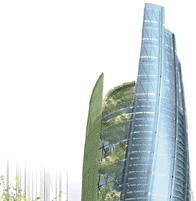
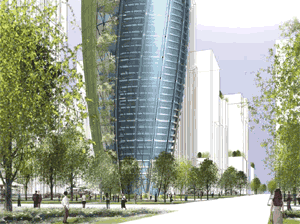
he told the gathered dignitaries, who were there to discuss alternative energy even as many of them hold the lion’s share of the world’s petroleum reserves.
The project was his team’s response to a commission by Fortune to design “a completely sustainable high-rise office building of the future.”
The host of that Summit was none other than Masdar, Abu Dhabi’s “multi-faceted, multi-billion dollar investment in the development and commercialization of advanced and innovative technologies in renewable, alternative and sustainable energies as well as green design.” It too seeks to be self-sustaining, via a new 64-million-sq.-ft. (6-million-sq.-m.) development that “uses the traditional planning principals of a walled city, together with existing technologies, to achieve a carbon neutral and zero waste community.” The master planner behind that project is U.K.-based Foster + Partners, which has no dearth of boldly envisioned edifices around the world.
Masdar’s city will be constructed “in an energy efficient two-stage phasing that relies on the creation of a large photovoltaic power plant, which later becomes the site for the city’s second phase, allowing for urban growth yet avoiding low density sprawl,” says the firm. With no cars, the city will place its inhabitants no farther than 656 ft. (200 m.) from the nearest transport link, contain plenty of well-designed shade for pedestrians and be circled by photovoltaic farms, research fields and plantations.
On January 21, the Abu Dhabi government committed $15 billion to the overall Masdar Initiative of which the walled city is a part, slated to fund projects targeting “solar, wind and hydrogen power; carbon reduction and management; sustainable development; education; manufacturing; and research and development.”
“For nearly half a century, the emirate of Abu Dhabi has used its natural resources to contribute to growth, development and security – our own as well as that of other countries,” said Masdar CEO Dr. Sultan Al Jaber. “Today, as global demand for energy continues to expand and as climate change becomes a real and growing concern, the time has come to look to the future. Our ability to adapt and respond to these realities will ensure that Abu Dhabi’s global energy leadership as well as our own growth and development continues.”
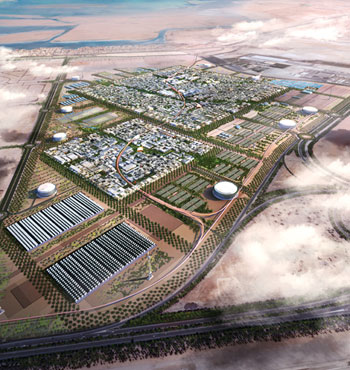
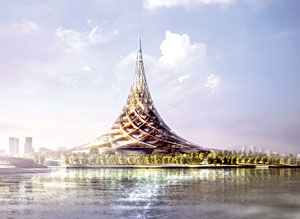
One of Foster’s other visions will result in the world’s largest inhabited building: “Crystal Island” in Moscow, Russia, will encompass a floor area of 26.9 million sq. ft. (2.5 million sq. m.). It will be located on the Nagatino Peninsula, a former industrial area along the Moscow River, and only a few miles from the Kremlin.
Granted preliminary planning permission by Moscow in late December, this project is seen as a “city within a city,” including museums, theaters, 3,000 hotel rooms, 900 apartments, 807,320 sq. ft. (75,000 sq. m.) of office space and an international school for 500 students. “Mixed-use also presents a strong case for energy balance, with individual components using energy at different times,” says the architecture firm, which has yet to reveal the developer’s identity.
More office and industrial space is both in demand and on the way, with projects springing up nearly as fast as rents. According to a recent NAI Global report on the city, “strong demand for office space, coupled with extremely low vacancy rates and low supply, continue to put upward pressure on rental rates, resulting in an average of $1,200 per square meter [US$111 per sq. ft.] per year for Class A office space. The inflow of foreign investors, combined with a lack of quality office properties, is compressing yields. It is difficult to find a new Class A office building for sale at a cap rate higher than 8 percent in Moscow.”
“It is the largest single building in the world, creating a year-round destination for Moscow and a sustainable, dynamic new urban quarter,” said Norman Foster of Crystal Island. “It is a paradigm of compact, mixed-use, sustainable city planning, with an innovative energy strategy and ‘smart’ skin which buffers against climate extremes.”
Some futuristic projects are not so sanguine. The high likelihood of a major earthquake in Turkey in the not-too-distant future has spurred engineers from the Republic of Turkey and Indiana-based Purdue University to propose the construction of a second city.
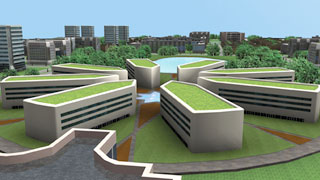
“It would use modern information technologies and be environmentally friendly,” said Mete Sozen, Purdue’s Kettelhut Distinguished Professor of Civil Engineering, in a January press release. “It would be safe, secure and modern. But more important is that this city would provide a refuge and emergency services in the event of an earthquake.”
Sozen thinks other natural disasters and rising ocean waters may cause many nations to consider building all-new cities in new locations. But Istanbul, with 12 million people working to support some 80 percent of the nation’s economy, is especially vulnerable.
Located just north of the North Anatolian fault, the city is at high risk for a major earthquake within the next 30 years, concluded an international study group led by Sozen in 2005. Much of Istanbul is threatened by earthquakes because of a combination of narrow passageways and lax construction standards in the past. The group concluded that bringing it up to modern preparedness standards would cost $50 billion: “At that point we began to think there might be another option,” said Sozen. “We could run away from the earthquake.”
No site for the proposed satellite city has been chosen.

o, it’s not a new electronic video game employing wands. It’s the shorthand employed by IBM Global Business Services for “Globally Integrated Enterprise.” IBM defines a GIE as a company that can reconfigure itself “far more rapidly than has been previously possible; can find, capture and deploy innovation wherever it exists in the world; and in so doing, increase the value that it creates.”
The new term comes with the October 2007 release of the company’s “Global Location Trends” report, based on corporate project activity in 2006 tracked by the Global Investment Locations Database (GILD) maintained by the company’s PLI-Global Location Services unit. Measured by number of projects and jobs, India led the way, followed by China and then the U.S. But when measured by per capita job creation and by R&D jobs per capita, whole new lists (below) emerged.
A trend toward sectoral and functional specialization in countries was balanced by a trend toward a wider scope of candidates considered in location decisions, meaning more discrete projects in a more widely dispersed menu of nations. The report found that “the concentration of investment among the top locations is diminishing, with the top 15 locations accounting for 73 percent of jobs created in 2006 as opposed to 85 percent in 2005.”
The early returns from Conway Data’s New Plant Database records for 2007 support trends from IBM’s 2006 data. Countries such as Vietnam, Malaysia, the Czech Republic, Poland, Romania, Hungary and several Arab states are jostling with more developed and diversified economies when measured by projects, investment and jobs created.
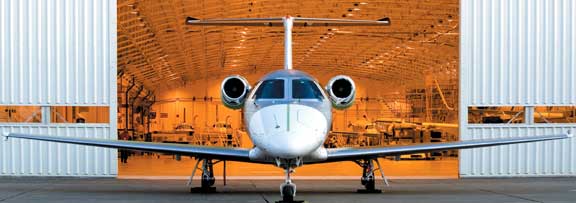
Grows at Home
razil-based aerospace firm Embraer saluted the solstice in December by inaugurating a new 201,285-sq.-ft. (18,700-sq.-m.) hangar for producing its US$3-million Phenom 100 and $6.6-million Phenom 300 executive jets, located at its Gavião Peixoto plant in outstate São Paulo, Brazil. By 2009, the company plans to perform final assembly of 120 to 150 jets per year at the facility.
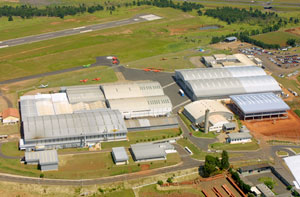
Orders for around 700 of the aircraft have already been received.
“I am absolutely certain that here, in this hangar, we will write a new and very successful page in the company’s history,” said Frederico Fleury Curado, Embraer president and CEO, on Dec. 21.
The company has been thriving in Brazil for nearly 40 years, and its property portfolio includes the continent’s longest runway, in Gavião Peixoto.
The new facility is part of a growth spurt that includes a $50-million investment at the company’s Botucatu complex (below), where the Phenom was first developed, and where a 98,500-sq.-ft. (9,151-sq.-m.) expansion has taken place.
More importantly for Brazilians, the work force is expanding from approximately 1,700 to 3,000 by the end of 2008.
Site Selection Online – The magazine of Corporate Real Estate Strategy and Area Economic Development.
©2008 Conway Data, Inc. All rights reserved. SiteNet data is from many sources and not warranted to be accurate or current.
Related Articles
Talent for Tomorrow
Workforce development efforts in Cameron County aim to meet industry needs of the future.
IAMC Insider: Cornerstone Streamlines Member-to-Member Information Sharing
Over time, the Corporate Active membership has become a community whose members share information with a high degree of confidence.
Research Pacts: A New Twist on the Public-Private Partnership
A Procter & Gamble executive explains how industrial participation
facilitates research and commercialization, benefiting regional research centers.
How the Good Life Found An Affordable Home in Southern California
Looking for tech talent and access to capital? Your search may end in San Bernardino County.